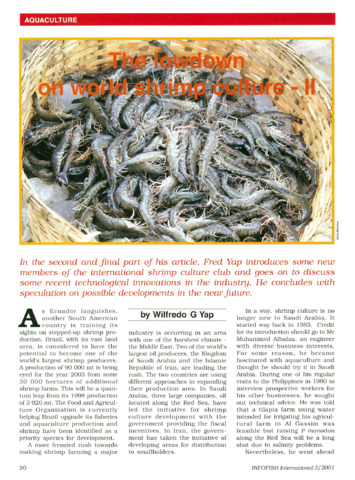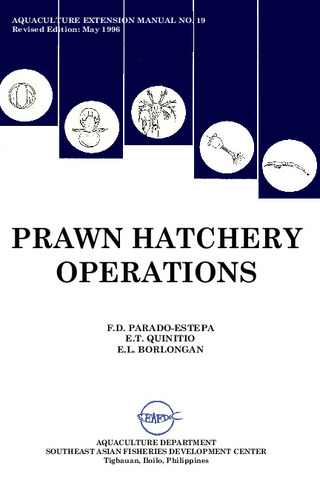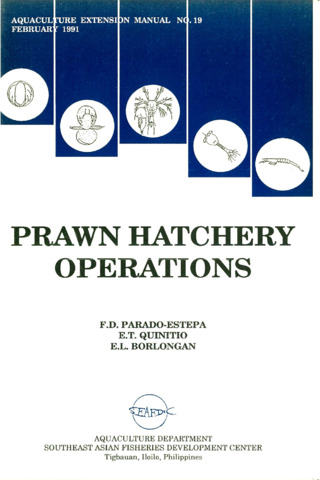| dc.contributor.author | Gonzales-Corre, K. | |
| dc.contributor.editor | Pullin, Roger S. V. | |
| dc.contributor.editor | Bhukaswan, T. | |
| dc.contributor.editor | Tonguthai, K. | |
| dc.contributor.editor | Maclean, J. L. | |
| dc.date.accessioned | 2011-06-22T09:35:11Z | |
| dc.date.available | 2011-06-22T09:35:11Z | |
| dc.date.issued | 1988 | |
| dc.identifier.citation | Gonzales-Corre, K. (1988). Polyculture of the tiger shrimp (Penaeus monodon) with Nile tilapia (Oreochromis niloticus) in brackishwater fishponds. In R. S. V. Pullin, T. Bhukaswan, K. Tonguthai, & J. L. Maclean (Eds.), The Second International Symposium on Tilapia in Aquaculture, Bangkok, Thailand, 16-20 March 1987 (pp. 15–20). Bangkok, Thailand : Department of Fisheries; Manila, Philippines: International Center for Living Aquatic Resources Management. | en |
| dc.identifier.isbn | 9711022605 | |
| dc.identifier.uri | http://hdl.handle.net/10862/304 | |
| dc.description.abstract | A study was conducted in fifteen 500-m2 ponds to determine the growth, survival and production of Penaeus monodon (Fabricius) in polyculture with Oreochromis niloticus (Linnaeus) and the extent of competition between shrimp and tilapia in brackishwater ponds. The treatments consisted of: (I) P. monodon at 6,000/ha; (II) O. niloticus at 6,000/ha; (III) O. niloticus at 4,000/ha; (IV) P. monodon at 6,000/ha plus O. niloticus at 6,000/ha; and (V) P. monodon at 6,000/ha plus O. niloticus at 4,000/ha. A completely randomized design with three replicates was used.
Treatment V gave the highest total production (283.32 kg/ha) followed by Treatment IV (221.24 kg/ha). Treatment I had the lowest total production. Analysis of variance on total production showed significant differences (p < 0.05) among treatments. Polyculture treatments (Treatments V and IV) were not different in terms of production but significant differences were observed between polyculture (Treatment V) and monoculture treatments (Treatments I, II and III). Mean net production of shrimp alone was highest in Treatment V followed by Treatment I and Treatment IV but were not significantly different between treatments. A similar trend was observed on the mean weight gain and percentage survival of P. monodon. Mean net production of O. niloticus was relatively low in all treatments. The low production of O. niloticus in all treatments was due to low survival (33% to 52%) and slow growth.
Competition was evident between P. monodon and O. niloticus at a stocking combination of 6,000 P. monodon/ha plus 6,000 O. niloticus/ha. Total yield from polyculture was better than monoculture. Polyculture of P. monodon at 6,000/ha and O. niloticus at 4,000/ha appeared feasible. | en |
| dc.language.iso | en | en |
| dc.subject | Oreochromis niloticus | |
| dc.subject | Penaeus monodon | |
| dc.subject.lcc | VF SP 092 | |
| dc.title | Polyculture of the tiger shrimp (Penaeus monodon) with Nile tilapia (Oreochromis niloticus) in brackishwater fishponds | en |
| dc.type | Conference paper | en |
| dc.citation.spage | 15 | |
| dc.citation.epage | 20 | |
| dc.subject.asfa | polyculture (aquaculture) | en |
| dc.subject.asfa | pond culture | en |
| dc.subject.asfa | brackishwater aquaculture | en |
| dc.subject.asfa | shrimp culture | en |
| dc.subject.asfa | yields | en |
| dc.subject.asfa | aquaculture systems | en |
| dc.citation.conferenceTitle | The Second International Symposium on Tilapia in Aquaculture, Bangkok, Thailand, 16-20 March 1987 | en |
| dc.subject.scientificName | Penaeus monodon | |



